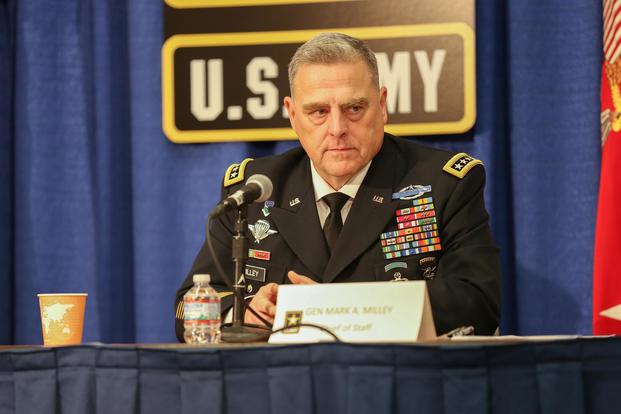The U.S. Army's chief of staff on Tuesday promised a groundswell in modernization reform that will bring a new generation of fighting vehicles, helicopters, soldier weapons and advanced combat training to ensure the service is ready for the next major war.
As the potential for war in North Korea and Europe increases, Gen. Mark Milley starkly stated that the service's current systems and process are "no longer adequate for a task of modernization for an Army of the Future."
"We know over time that our competitive advantage has eroded, our overmatch is being challenged in all domains," Milley told a large audience at the Association of the United States Army's 2017 annual meeting.
Acting Army Secretary Ryan McCarthy yesterday announced a series of fundamental changes designed to restructure the way the service approaches modernization.
Related content:
- Army Leaders to Create New Command to Fix Modernization Woes
- Next Army Combat Vehicle May Feature Active Protection, Laser Weapons
- Full Coverage of the 2017 AUSA Annual Meeting & Exposition
The reform effort, Milley said, includes a new command designed to consolidate the methods that deliver Army capabilities, much like the approach used by U.S. Special Operations Command.
"Faster results will be obtained ... as we shift to a SOCOM-like model of buy, try, decide and acquire rather than the current industrial-age linear model that takes years to establish requirements, decades to test, and it may take a long, long time to go from idea to delivery," he said.
Six Priorities
Milley then tried to paint a picture of the Army as a result of the reform effort's six modernization priorities -- long-range precision fires; next generation combat vehicle; future vertical lift; a mobile and expeditionary network; air and missile defense capabilities; and soldier lethality.
"We are investing heavily in long-range precision fires," he said. "We are going to rapidly modernize Army rocket and tube artillery, but this will not be the artillery of yesteryear. This will be an artillery to strike with land-based precision fires at very extended ranges that our enemies will never expect."
The second and third priorities will focus on new platforms for both ground and air mobility, Milley said.
"We will increase our capability to move and engage in close combat with the next generation of family of combat vehicles and our Future Vertical Lift -- new tanks, new infantry vehicles, wheeled vehicles and rotary-wing aircraft," he said.
This new-class of platforms will "leverage new technologies in firepower; mobility; armor; materials; active-protective systems; lighter-weight; new forms of power generation beyond carbon-based fuels and more importantly robotics," Milley said.
The Army will also have a new tactical network that will "enable us to conduct mission command on the move in a fluid and high-threat environment," he said.
Army network officials recently told Congress the service will soon stop buying the General Dynamics-made Warfighter Information Network-Tactical -- a $6-billion investment that has formed the backbone of the its tactical network -- and search for a new system to deal with emerging threats.
The future network technology "will be expeditionary, mobile and hardened to survive in an active electronic warfare environment, and it will leverage emerging technologies of artificial intelligence and machine learning," Milley said.
The Army also plans to upgrade its outdated air and missile defense system to protect the force against enemy indirect fires and air and missile attack, he said.
And since the Army's success rests on soldiers engaged in close combat, Milley said, the service intends "to significantly increase investments in rapidly increasing individual soldier and collective soldier lethality."
"Our next individual and squad combat weapons will come in with a 10X improvement over any existing current system in the world, and that will be critical," he said.
'Training Is the Key'
New equipment is important, but "training is the key," Milley said.
The Army will always emphasize live-fires and exercises against opposing force units at the service's combat training centers, he said.
"But live-fire and live force-on-force training -- that is expensive and it doesn't provide nearly enough repetition for developing high levels of soldier and leader skills needed in future battle," Milley said.
For that reason, the Army plans to "radically improving our synthetic training environment," he said.
"We currently do simulations for Air Force and Navy pilots and for our own helicopter pilots," Milley said. "Tens of millions of dollars are spent on training simulations for an F-35 fighter pilot before they are ever allowed to come near a fifth-generation fighter.
"Any soldier that engages in close-quarters combat deserves the same investment for anyone that is flying at 30,000 feet. There is no reason we can't do that; the technology already exists," he said.
Milley warned that the Army must modernize quickly to increase its lethality and regain its competitive advantage against the emerging threats of the future.
"If we adapt to the changing character of war, and we embrace the institutional changes that we need to implement, then we will continue to be the most lethal fighting force in the world for the next seven decades and beyond," he said.
"If we do not, we will lose the next war," Milley warned.
-- Matthew Cox can be reached at matthew.cox@military.com.





























